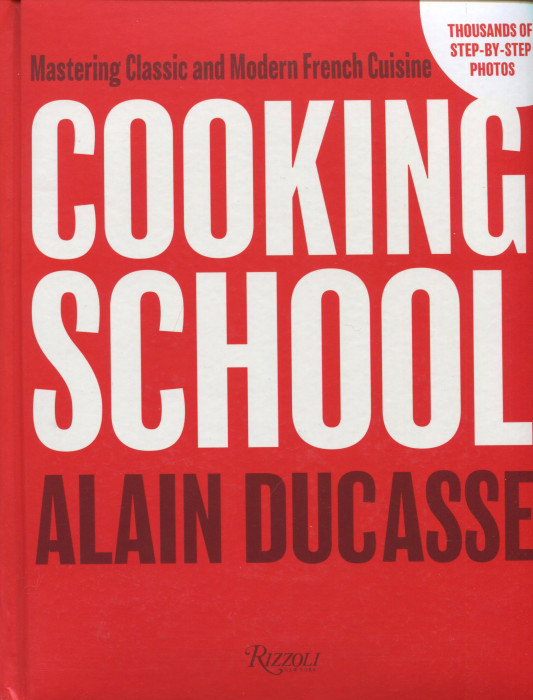With an empire of over twenty restaurants and a portfolio of a dozen plus cookbooks, Alain Ducasse is as prolific as he is wonderful. Suzi and I can still remember a Paris lunch fifteen years ago, the truffle tasting lunch, where we experienced a meal that was mind-blowing with truffles employed in every dish from appetizer to, yes, dessert. To call it spectacular is to minimize the excellence.
After dining at one of his restaurants, the typical reaction is a mix of amazement with a little tinge of culinary remorse. “If only I could do that at home,” you say to yourself. For many of his recipes, I would not know where to begin. I would need a picture. Or two. Or lots of pictures.
Alain’s latest book is Cooking School: Mastering Classic and Modern French Cuisine. It comes with that picture. It comes with thousands of pictures.
The two hundred recipes in this book are each accompanied by multiple photos, numbered to match the numbering of the paragraphs in the actual recipe. Not every step has a photo, just the ones where you might need some visual assistance. So, the picture of the finished apple tart shows concentric rings of perfectly spaced thin slices of apples. How do you achieve that perfect artistry? There are five photos for the six steps and you see exactly how to make that critical circular arrangement. If you were amazed with this dessert in a Ducasse restaurant, then here is good news: you can do it too!
When you eat at a Ducasse restaurant, you appreciate the staff and you realize that the kitchen is manned 24 X 7. Sauces, stocks, breads and desserts are being created in the dark of night. And some recipes are so complex they do need serious preparation time.
Do those magnus recipes appear here? Yes and no. The 200 recipes here are assembled in three chapters organized, not by recipe type, but by effort. Easy, Intermediate, and Difficult recipes provide an easy path to Ducasse-class recipes along with the option to “go all the way” with some dish of vast complexity and reward.
The assembly of recipes here is extensive, exciting, and destined to occupy you for months or years. Here’s a sample of ideas that caught my eye at first pass through the book.
Easy:
Celeriac and apple remoulade
Eggplant caviar
Panna cotta with peaches and caramelized almonds
Zucchini flower fritters
Intermediate:
Cod sticks with red bell pepper sauce
Duck roulade with apple chutney
Foie gras terrine with pears
Steamed salmon with shiitake mushrooms and sea beans
Difficult:
Foie gras poached in broth
Potato ravioli
Roasted lion of lamb stuffed with spinach and almonds
Saint Honoré cake
The recipes here will let you mix-and-match to meet your flavor needs and your culinary skills. Start Easy, learn with ease, and gravitate to the Difficult. The book includes a 70-page appendix that, rich again with photos, describes tools, basic ingredients, and basic recipes and techniques. You’ll find yourself dashing back and forth between that deep pool of information and the magnificent array of recipes.
Perhaps you’ve never had the opportunity to “dine-Ducasse.” Gee, now you get to both dine and cook Ducasse. This is an important, world-class book. If you bring a copy home, it will not sit on your shelf. You will use it and you’ll become a better home chef. And your family will know it! [You don’t have a family? You dine alone? Then dine well, really, really well!]

